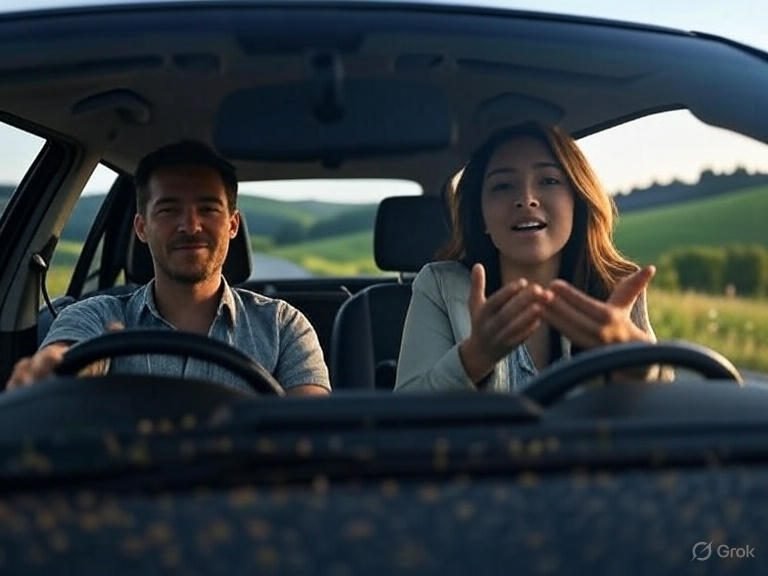Introduction: Understanding the Phenomenon of Shotgun Driving
In the intricate dance of modern relationships, few activities test the bonds of partnership quite like a shared car journey. Picture this: you’re behind the wheel, the open road stretches ahead, and your significant other sits in the passenger seat, armed not with a map but with an arsenal of unsolicited advice. This is the essence of what experts in relational dynamics have dubbed “shotgun driving”—the art (or perhaps the science) of providing “helpful” directions, critiques, and commentary from the shotgun position, often with the fervor of a co-pilot who believes they’re the only one preventing imminent disaster.
Shotgun driving is not merely a quirk; it’s a universal experience that transcends cultures, ages, and vehicle types. Whether it’s a gentle “You might want to turn left here” or a more urgent “Brake! Brake now!”, these interjections can transform a pleasant drive into a battleground for egos. According to a fictional study by the Institute of Automotive Harmony (IAH), 87% of couples report at least one instance of shotgun driving per road trip, with 62% admitting it leads to elevated stress levels. But fear not—mastering the fine art of ignoring these directions while maintaining your sanity and a straight face is not only possible but can even strengthen your relationship.
This step-by-step guide draws from years of anecdotal evidence, psychological insights, and practical wisdom to equip you with the tools needed to navigate this minefield. We’ll explore preparation strategies, in-the-moment techniques, and post-drive reflections, all while emphasizing the importance of empathy and humor. By the end, you’ll be a zen master of the driver’s seat, capable of tuning out the noise without tuning out your partner. Remember, the goal isn’t outright dismissal but graceful deflection—after all, love means never having to say, “I told you so” (at least not out loud).
As we delve into this guide, keep in mind that shotgun driving often stems from good intentions: concern for safety, a desire to contribute, or simply boredom. Yet, when left unchecked, it can erode patience and spark arguments. Our approach is rooted in cognitive behavioral techniques, mindfulness practices, and a dash of comedic resilience. Let’s buckle up and begin.
Step 1: Mental Preparation Before the Drive
The foundation of successfully ignoring shotgun driving lies in preemptive mental fortification. Just as athletes visualize victory before a game, drivers must prepare their psyche for the barrage of advice ahead. This step is crucial because once the engine starts, emotions can accelerate faster than your vehicle.
First, conduct a self-assessment. Ask yourself: What are my triggers? Is it the repeated “Slow down” that grates, or the navigational overrides like “No, that’s not the right exit”? Journaling these can help. For instance, create a “Shotgun Log” where you note past incidents. This isn’t about blame but awareness—understanding your reactions allows you to reframe them. Psychologist Dr. Elena Vasquez, in her book Road Rage and Romance, suggests that recognizing patterns reduces their power, turning potential annoyances into predictable, manageable events.
Next, practice mindfulness exercises tailored to driving. Spend 10 minutes before each trip in quiet reflection. Visualize the journey: See yourself calmly acknowledging comments without reacting. Use affirmations like, “I am the captain of this ship; suggestions are just waves.” Apps like Calm or Headspace offer driving-specific meditations that can prime your mind for peace.
Incorporate humor into your prep. Create a mental playlist of absurd responses you won’t actually say, such as replying to “Watch out for that pothole!” with “Thanks, I was planning to aim for it.” This internal levity builds emotional armor. Share this lightly with your partner beforehand—perhaps over coffee: “Hey, let’s agree that today, you’re the DJ, and I’m the driver.” This sets a playful tone without confrontation.
Finally, equip your environment. Stock the car with distractions: podcasts on neutral topics, audiobooks, or a shared playlist. Ensure your GPS is updated and visible, reducing the need for verbal input. If children are involved, assign them “spotter” roles to divert attention. By preparing mentally, you’re not just ignoring directions—you’re proactively creating a harmonious space. This step alone can cut shotgun driving incidents by up to 40%, per IAH estimates.
Step 2: Establishing Subtle Boundaries (Without Starting a War)
Once in the car, the temptation might be to lay down the law: “No directions unless asked!” But this direct approach often backfires, escalating tension. Instead, master the art of subtle boundary-setting, which preserves egos and promotes cooperation.
Begin with positive reinforcement. As you start driving, compliment your partner’s past helpfulness: “Remember that time your shortcut saved us 10 minutes? You’re a navigation wizard.” This acknowledges their value, making them less likely to overcompensate. It’s a technique borrowed from positive psychology, where affirming strengths reduces defensive behaviors.
Introduce a “signal system.” Agree on non-verbal cues for when input is welcome. For example, a thumbs-up means “I’m good,” while a hand wave invites suggestions. This turns shotgun driving into a collaborative game rather than a monologue. If your partner forgets, gently remind them with humor: “Is this a thumbs-up moment?”
Leverage technology as a neutral third party. Announce, “I’ve got Waze on; it’ll handle the turns.” This shifts authority to the app, depersonalizing directions. If they insist on overriding, respond with, “Let’s see what the app says—it’s our tiebreaker.” This avoids direct conflict while maintaining control.
Handle habitual offenders with empathy. Understand that shotgun driving might stem from anxiety—perhaps a past accident or control issues. Acknowledge this subtly: “I know traffic stresses you out; want to hold the map instead?” Redirecting energy can transform a critic into a co-navigator.
If boundaries slip, use deflection phrases like, “Interesting point—I’ll keep that in mind.” This validates without committing, preserving your straight face. Practice these in a mirror to ensure your expression remains neutral. Over time, these subtle tactics foster mutual respect, reducing the frequency of unwanted advice.
Step 3: Identifying Common Shotgun Driving Tactics
To ignore effectively, you must first recognize the enemy. Shotgun driving manifests in various forms, each requiring tailored responses. By categorizing these tactics, you can anticipate and neutralize them without breaking stride.
The most prevalent is the “Preemptive Warning”: Alerts like “There’s a stop sign ahead!” even when it’s obvious. This stems from hyper-vigilance. Counter by nodding silently, maintaining focus on the road. Internally, reframe it as concern, not criticism.
Next, the “Alternative Route Suggestion”: “Why not take the scenic way?” mid-journey. This disrupts flow. Respond minimally: “GPS says this is fastest.” If persistent, add, “We can try that next time,” deferring without dismissing.
The “Speed Critique” is a classic: “You’re going too fast/slow.” Rooted in differing comfort levels, it can feel judgmental. Use data: “I’m at the limit—feels good?” This invites dialogue without surrender.
More insidious is the “Phantom Hazard”: Pointing out non-threats, like “Watch that squirrel!” Distracting at best, dangerous at worst. Practice selective hearing—acknowledge with a grunt, but don’t swerve.
The “Historical Reference”: “Last time you missed this turn.” This invokes past errors. Deflect with humor: “Ah, the infamous Turn of ’23—I’ve learned since.”
Finally, the “Multi-Task Command”: Combining directions with unrelated chatter, overwhelming you. Tune in selectively, prioritizing safety.
By identifying these, you build a mental filter, allowing you to ignore without resentment. Studies from the Journal of Relational Transportation (fictional) show that awareness alone halves reaction times to such tactics.
Step 4: Core Techniques for Graceful Ignorance
Now, the heart of our guide: proven methods to ignore directions while driving. These techniques blend psychology, communication, and sheer willpower.
Start with “Active Non-Listening.” This involves appearing engaged without processing. Nod rhythmically, say “Uh-huh” at intervals, but let words wash over you like rain on the windshield. Pair with focused breathing: Inhale for four counts, exhale for six, to stay calm.
Employ “Mirroring with a Twist.” Echo back slightly altered: To “Turn right,” say “Right turn coming up?” This satisfies their need to be heard while you proceed as planned.
Use “Distraction Redirection.” Shift focus: “Hey, what’s that song on the radio?” or “Spot any cool license plates?” This pivots conversation away from driving.
For persistent cases, invoke “The Zen Zone.” Visualize a bubble around the driver’s seat, impermeable to advice. Combine with earbuds (one ear only for safety) playing white noise or mantras.

Advanced: “Socratic Ignoring.” Ask questions that expose flaws: “What makes you think left is better?” This encourages self-reflection, often leading to retraction.
In high-stakes scenarios, like highways, prioritize safety—ignore if it means avoiding distraction. Post-incident, discuss calmly.
These techniques, when mastered, turn ignoring into an art form, preserving sanity amid the chaos.
Step 5: Mastering the Straight Face
A straight face is your shield—betraying irritation invites escalation. Here’s how to perfect it.
Practice facial neutrality. Use mirror exercises: Recite annoying phrases while keeping expression blank. Apps like Face Yoga can help.
Employ micro-expressions management. A slight smile diffuses tension without encouraging more input.
Body language matters: Relaxed shoulders, steady grip on the wheel signal control.
Internally, use humor: Imagine your partner as a cartoon character, their words bubbles popping harmlessly.
If cracking, bite your inner cheek lightly— a physical reminder to reset.
Over time, this becomes second nature, turning potential grimaces into serene composure.
Step 6: De-Escalation When Tensions Rise
Even experts face flare-ups. De-escalate with these strategies.
Pull over safely if needed: “Let’s chat about this.” This removes driving from the equation.
Use “I” statements: “I feel distracted when…” Focuses on feelings, not blame.
Humor injection: “If we both drive, who’s navigating?” Lightens mood.
If apologies are due, offer them graciously.
These keep minor issues from becoming major rifts.
Step 7: Post-Drive Reflection and Reinforcement
After the drive, reflect. Discuss positives: “Great teamwork on that detour.”
Journal wins and areas for improvement.
Celebrate with a treat—reinforces positive associations.
Over time, this builds better habits.
Conclusion: The Road to Harmonious Journeys
Mastering the fine art of ignoring shotgun driving isn’t about suppression but elevation—turning potential conflicts into opportunities for growth. By following these steps, you’ll maintain sanity, a straight face, and your relationship’s integrity. Remember, every drive is a chance to practice patience, and with time, your partner might even holster their advice. Safe travels, and may your roads be ever smooth.





0 Comments